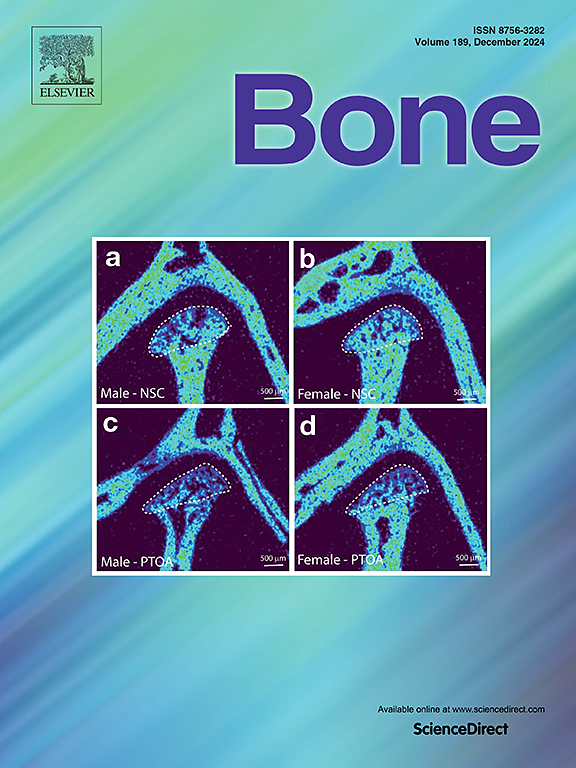Efficacy of stem cell therapy for avascular necrosis of the femoral head: A systematic review and Meta-analysis
IF 3.6
2区 医学
Q2 ENDOCRINOLOGY & METABOLISM
引用次数: 0
Abstract
Background
Osteonecrosis of the femoral head (ONFH) is a debilitating orthopaedic condition primarily affecting younger adults, often progressing to femoral head collapse and total hip replacement (THR). Stem cell therapy (SCT) has emerged as a regenerative option to delay disease progression and preserve joint function. This study aimed to evaluate efficacy of SCT, alone or in combination with mechanical support or bone grafting, in improving clinical outcomes in ONFH.
Methods
A comprehensive search was conducted up to November-2024. Randomized controlled trials (RCTs) comparing SCT with standard care in ONFH patients were included. Primary outcomes were THR incidence and disease progression; secondary outcomes included Harris Hip Score (HHS), Visual Analog Scale (VAS), Western Ontario and McMaster Universities Osteoarthritis Index (WOMAC). Data were pooled using random-effects models, and evidence certainty was assessed using the GRADE approach.
Results
Ten RCTs involving 545 hips were included, with overall mean follow-up duration across studies was 36 months. SCT, when used in combination with mechanical support or bone grafts, showed a trend towards reduced THR risk (RR: 0.74; 95 % CI: 0.46–1.20) and significantly improved functional outcomes (e.g., WOMAC MD: –10.7; 95 % CI: −17.2 to −4.3). Pure SCT alone did not yield statistically significant benefits across most outcomes. Subgroup analyses revealed that mechanical support notably enhanced the effect of SCT on HHS and THR prevention. The risk of bias was low in six studies and high in four. GRADE assessment rated the evidence as moderate for THR and low for other outcomes due to methodological limitations.
Conclusion
While pure SCT appears deceptive in ONFH treatment, its combined use with mechanical support or bone grafts might be promising.
干细胞治疗股骨头缺血性坏死的疗效:系统回顾和荟萃分析。
背景:股骨头坏死(ONFH)是一种使人衰弱的骨科疾病,主要影响年轻人,通常进展为股骨头塌陷和全髋关节置换术(THR)。干细胞治疗(SCT)已成为延缓疾病进展和保持关节功能的再生选择。本研究旨在评估SCT单独或联合机械支持或植骨对改善ONFH临床结果的疗效。方法:全面检索至2024年11月。随机对照试验(rct)比较了ONFH患者的SCT和标准治疗。主要结局是THR发病率和疾病进展;次要结局包括Harris髋关节评分(HHS)、视觉模拟量表(VAS)、Western Ontario和McMaster university Osteoarthritis Index (WOMAC)。使用随机效应模型汇总数据,并使用GRADE方法评估证据确定性。结果:纳入了10项随机对照试验,涉及545髋,研究的总体平均随访时间为36 个月。当SCT与机械支持或骨移植联合使用时,THR风险有降低的趋势(RR: 0.74;95 % CI: 0.46-1.20)和显著改善的功能结局(例如,WOMAC MD: -10.7;95 % CI: -17.2至-4.3)。在大多数结果中,单纯的SCT不能产生统计学上显著的益处。亚组分析显示,机械支持显著增强了SCT对HHS和THR预防的作用。6项研究的偏倚风险较低,4项研究的偏倚风险较高。GRADE评估认为,由于方法学的限制,该证据在THR方面为中等水平,在其他结果方面为低水平。结论:虽然单纯的SCT在ONFH治疗中似乎具有欺骗性,但它与机械支持或骨移植的联合使用可能是有希望的。
本文章由计算机程序翻译,如有差异,请以英文原文为准。
求助全文
约1分钟内获得全文
求助全文
来源期刊

Bone
医学-内分泌学与代谢
CiteScore
8.90
自引率
4.90%
发文量
264
审稿时长
30 days
期刊介绍:
BONE is an interdisciplinary forum for the rapid publication of original articles and reviews on basic, translational, and clinical aspects of bone and mineral metabolism. The Journal also encourages submissions related to interactions of bone with other organ systems, including cartilage, endocrine, muscle, fat, neural, vascular, gastrointestinal, hematopoietic, and immune systems. Particular attention is placed on the application of experimental studies to clinical practice.
 求助内容:
求助内容: 应助结果提醒方式:
应助结果提醒方式:


